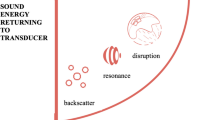Abstract
The safety and benefits of cardiac contrast-enhanced ultrasound (CEUS) have been demonstrated in children and adolescents for a variety of clinical indications, including congenital heart disease. Cardiac CEUS is performed with US and the intravenous administration of ultrasound contrast agents (UCAs). It improves transthoracic echocardiography, which can be challenging in children and adults with acoustic window limitations (e.g., from obesity) and alterations in chest wall and cardiac geometry (e.g., from prior surgical procedures). Cardiac CEUS is also used to evaluate ischemia in the follow-up of congenital and acquired heart disease. In 2019, the United States Food and Drug Administration (FDA) approved a UCA for pediatric echocardiography. This article focuses on the clinical applications of UCAs in pediatric and adult echocardiography, outlining its diagnostic value, safety and potential for future applications.









Similar content being viewed by others
References
Abdelmoneim SS, Bernier M, Scott CG et al (2010) Safety of contrast agent use during stress echocardiography in patients with elevated right ventricular systolic pressure: a cohort study. Circ Cardiovasc Imaging 3:240–248
Khawaja OA, Shaikh KA, Al-Mallah MH (2010) Meta-analysis of adverse cardiovascular events associated with echocardiographic contrast agents. Am J Cardiol 106:742–747
Main ML, Goldman JH, Grayburn PA (2007) Thinking outside the "box" — the ultrasound contrast controversy. J Am Coll Cardiol 50:2434–2437
Calliada F, Campani R, Bottinelli O et al (1998) Ultrasound contrast agents: basic principles. Eur J Radiol 27:S157–S160
Gramiak R, Shah PM (1968) Echocardiography of the aortic root. Investig Radiol 3:356–366
Bracco Diagnostics (2021) Lumason. https://imaging.bracco.com/sites/braccoimaging.com/files/technica_sheet_pdf/us-en-2017-01-04-spc-lumason.pdf. Accessed 19 May 2021
GE Healthcare (2016) Optison. http://www3.gehealthcare.com/~/media/documents/MarketoPDFsnogating/OPT-1H-OSLO_Optison_BK. Accessed 19 May 2021
United States Food and Drug Administration (2011) Highlights of prescribing information: Definity. https://www.accessdata.fda.gov/drugsatfda_docs/label/2011/021064s011lbl.pdf. Accessed 19 May 2021
Muskula PR, Main ML (2017) Safety with echocardiographic contrast agents. Circ Cardiovasc Imaging 10:e005459
Porter TR, Mulvagh SL, Abdelmoneim SS et al (2018) Clinical applications of ultrasonic enhancing agents in echocardiography: 2018 American Society of Echocardiography guidelines update. J Am Soc Echocardiogr 31:241–274
Porter TR, Abdelmoneim S, Belcik JT et al (2014) Guidelines for the cardiac sonographer in the performance of contrast echocardiography: a focused update from the American Society of Echocardiography. J Am Soc Echocardiogr 27:797–810
Rafter P, Phillips P, Vannan MA (2004) Imaging technologies and techniques. Cardiol Clin 22:181–197
National Institutes of Health (2021) Study to determine dosage of Optison in pediatric patients. ClinicalTrials.gov. https://clinicaltrials.gov/ct2/show/NCT03740997. Accessed 19 May 2021
McMahon CJ, Ayres NA, Bezold LI et al (2005) Safety and efficacy of intravenous contrast imaging in pediatric echocardiography. Pediatr Cardiol 26:413–417
Zilberman MV, Witt SA, Kimball TR (2003) Is there a role for intravenous transpulmonary contrast imaging in pediatric stress echocardiography? J Am Soc Echocardiogr 16:9–14
Kutty S, Olson J, Danford CJ et al (2012) Ultrasound contrast and real-time perfusion in conjunction with supine bicycle stress echocardiography for comprehensive evaluation of surgically corrected congenital heart disease. Eur Heart J Cardiovasc Imaging 13:500–509
Kutty S, Xiao Y, Olson J et al (2016) Safety and efficacy of cardiac ultrasound contrast in children and adolescents for resting and stress echocardiography. J Am Soc Echocardiogr 29:655–662
Hoffmann R, Barletta G, von Bardeleben S et al (2014) Analysis of left ventricular volumes and function: a multicenter comparison of cardiac magnetic resonance imaging, cine ventriculography, and unenhanced and contrast-enhanced two-dimensional and three-dimensional echocardiography. J Am Soc Echocardiogr 27:292–301
Goldberg AB, Lama von Buchwald C, Kalra DK, Rao AK (2019) An unusual cardiac metastasis: right atrial chondrosarcoma diagnosed with multimodality cardiac imaging. CASE 3:162–166
Bisoyi S, Dash AK, Nayak D et al (2016) Left ventricular pseudoaneurysm versus aneurysm a diagnosis dilemma. Ann Card Anaesth 19:169–172
Main ML, Hibberd MG, Ryan A et al (2014) Acute mortality in critically ill patients undergoing echocardiography with or without an ultrasound contrast agent. JACC Cardiovasc Imaging 7:40–48
Wever-Pinzon O, Suma V, Ahuja A et al (2012) Safety of echocardiographic contrast in hospitalized patients with pulmonary hypertension: a multi-center study. Eur Heart J Cardiovasc Imaging 13:857–862
Ntoulia A, Anupindi SA, Back SJ et al (2021) Contrast-enhanced ultrasound: a comprehensive review of safety in children. Pediatr Radiol. In press
Kutty S, Wu J, Hammel JM et al (2012) Microbubble mediated thrombus dissolution with diagnostic ultrasound for the treatment of chronic venous thrombi. PLoS One 7:e51453
Kutty S, Liu N, Zhou J et al (2017) Ultrasound induced microbubble cavitation for the treatment of catheterization induced vasospasm. JACC Basic Transl Sci 2:748–756
Mathias W Jr, Arrieta SR, Tavares GMP et al (2019) Successful recanalization of thrombotic occlusion in pulmonary artery stent using sonothrombolysis. CASE 3:14–17
Author information
Authors and Affiliations
Corresponding author
Ethics declarations
Conflicts of interest
Dr. Feinstein is a speaker for GE Healthcare and Bracco Imaging. Dr. Kutty is a consultant for GE Healthcare.
Additional information
Publisher’s note
Springer Nature remains neutral with regard to jurisdictional claims in published maps and institutional affiliations.
Rights and permissions
About this article
Cite this article
Kutty, S., Biko, D.M., Goldberg, A.B. et al. Contrast-enhanced ultrasound in pediatric echocardiography. Pediatr Radiol 51, 2408–2417 (2021). https://doi.org/10.1007/s00247-021-05119-3
Received:
Revised:
Accepted:
Published:
Issue Date:
DOI: https://doi.org/10.1007/s00247-021-05119-3




